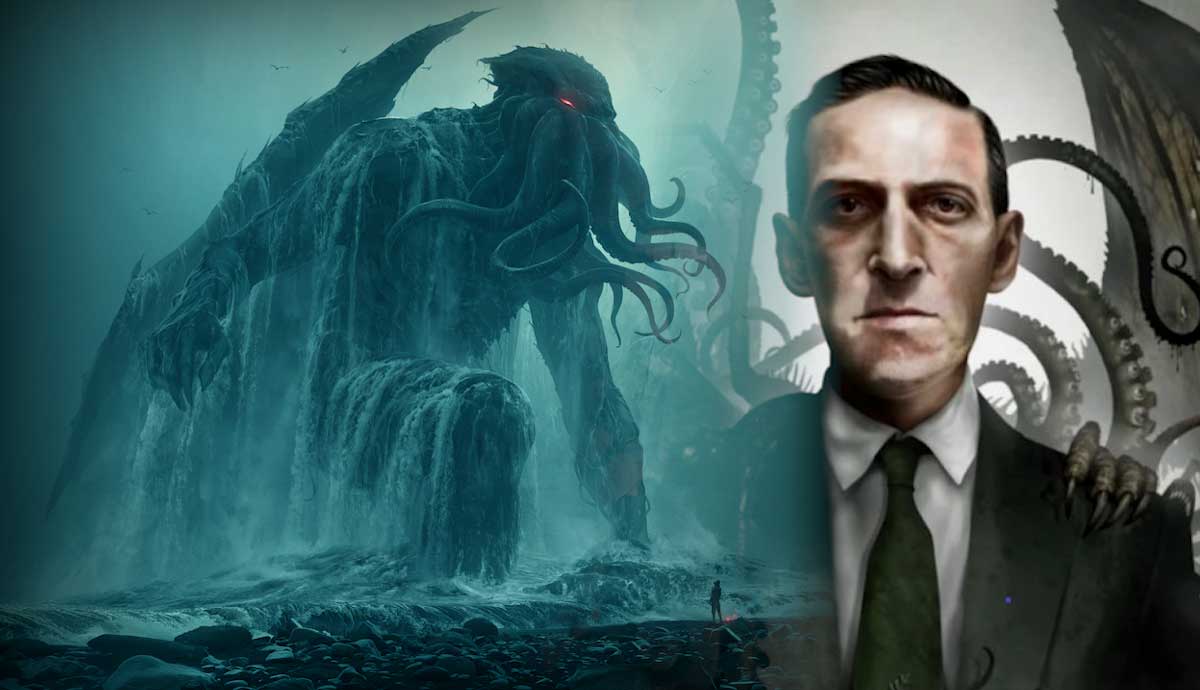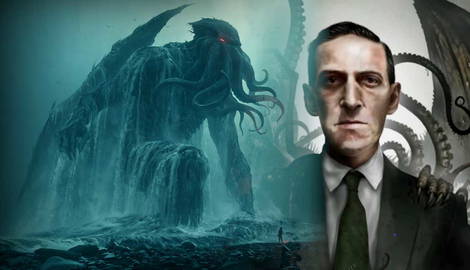
In the early years of the 20th century, a horror writer in Providence, New England was feverishly detailing the terrifying visions that his imagination held. He struggled in life, psychologically and financially, but what he wrote would achieve cult status and be recognized as the seminal works of horror that would inspire generations in the following decades. Authors such as Stephen King would cite H.P. Lovecraft as his primary influence.
What Lovecraft introduced us to, however, was no ordinary horror. It was a new type of horror that had its origins in space and beyond the realms of human understanding. His genre was that of “cosmic horror,” and the monsters he created were so terrifying that those unlucky enough to encounter them would lose their sanity.
The works of H.P. Lovecraft outlived their author. They were picked up by subsequent writers who added to the shared universe that he created, constructing, in the process, a massive backdrop that came to be known as the Lovecraftian or Cthulhu Mythos.
The Cthulhu Mythos

The “Cthulhu Mythos,” coined by the writer August Derleth, is all the shared elements of H.P. Lovecraft’s created world, with all its characters and horrors. It also includes the creations of writers, film, and game creators who have added to the unofficial canon of Lovecraft’s work. Since all of Lovecraft’s writings are now public domain, there is little legal ramification in borrowing ideas from them and adding to their lore with the intention of being published. As such, it has become an immensely popular “mythos” with a dedicated cult following.
The development of the Cthulhu Mythos can be neatly separated into several chronological stages. The first stage of development was one characterized by Lovecraft himself when he was alive and writing. In the latter part of his life, the mythos expanded significantly as a small group of authors, with whom Lovecraft corresponded, borrowed themes and elements from Lovecraft as well as each other. Some of the writers in the “Lovecraft Circle” were famed during the era of pulp magazines, and their tales could be found within the covers of Weird Tales and other science fiction and horror pulps.

Of particular note was the author Robert E. Howard, the creator of the Conan stories. Lovecraft and Howard kept in regular contact and would pay homage to each other’s works by referencing them in their own stories. Although they did not create stories centered around each other’s characters, they created a mythos that became canon as elements of a shared universe.
Despite the popularity of the Cthulhu Mythos, it was never intended to serve as the central story in any of these authors’ works. Instead, it serves as a backdrop to other stories and, as such, provides a setting that is ominous, malevolent, and utterly unconcerned with the feelings of a pitifully insignificant human species.

The second stage of development for the Cthulhu Mythos came after Lovecraft’s death and with the writings of August Derleth, who expanded the Mythos with his broad canon. Derleth took the distinct story cycles of Lovecraft and combined them into one, adding his own good-versus-evil dichotomy that was absent in Lovecraft’s work. This represents a huge shift from the dark and nihilistic visions of the original writings and is subject to fierce debate by many fans who reject the notion of adding an element of goodness to Lovecraft’s creations, claiming that it detracts from the depressive horror that Lovecraft intended. Nevertheless, for many decades after Lovecraft’s death, Derleth kept the Cthulhu Mythos alive and added an immeasurable amount of literature to it, all through his own publishing house.

The third and final stage of development was further writing by a number of authors, chief among them being Lin Carter, who attempted to codify and classify all the Cthulhu Mythos themes and creations. This was supported in 1981 with the launch of a Call of Cthulhu table-top role-playing game (like Dungeons & Dragons), developed by Sandy Petersen, which also required the Cthulhu Mythos to be classified in encyclopedic form for ease of reference.
Finally codified, the Mythos was broken down into gods and species. From Lovecraft’s original writings, The Great Old Ones were several malignant species that had once ruled Earth. These Great Old Ones include beings such as the Chthonians, the Deep Ones, the Elder Things, and the Mi-Go. The Outer Gods were several ancient and powerful cosmic deities that exist beyond the confines of Earth and even the solar system. They exert their influence from a galactic perspective.
Some of the Monsters & the Stories

Lovecraft was a prolific writer of short stories, and each story introduces the audience to a new god, monster, or alien species. Subsequent writers expanded the Cthulhu Mythos and added their own creations to the shared universe. Providing an exhaustive and encyclopedic reference to all the themes, gods, and monsters is a tall task, but there are a few that deserve special mention as being the important progenitors of the Mythos and who gathered cult fame from the Lovecraft fanbase.
The god for which the Cthulhu Mythos is named is from the story “The Call of Cthulhu,” which appeared in Weird Tales in 1928. The story involves the discovery of the city-island of R’lyeh, where sailors inadvertently awaken the eponymous being, a “Great Old One” – a member of a loose pantheon of cosmic beings that ruled the earth and then fell into a deep slumber. Lovecraft described Cthulhu as having the features of an octopus, a dragon, and a caricature of the human form. His visage was so frightening that two of the sailors immediately dropped dead with fright upon seeing him.

In another of Lovecraft’s most loved stories, The Shadow Over Innsmouth (1931), we are introduced to a race of immortal sea-dwelling, humanoid fish creatures known as the Deep Ones. The story follows a journalist who stops over in the town of Innsmouth, where he finds a population of strangely odd people who end up trying to kill him to protect their secret. The secret these people keep is that they are Deep One hybrids – the result of the coupling of a human father and a Deep One mother. The result is a hybrid that, at birth, looks completely human but becomes more fishlike as it ages, eventually returning to the sea once the transformation process is complete.

At the Mountains of Madness (1931) describes creatures called the Elder Things, a race of aliens that colonized Earth a billion years ago. They stand roughly eight feet tall and have elongated barrel-shaped bodies with starfish-shaped appendages at both ends. The top appendage has five eyes and five eating tubes, while the bottom has five limbs. They also have five leathery wings which retract through slits into their bodies.
The Elder things are noted for creating a servitor race, the shoggoths, which are formless mounds of flesh adorned with numerous tentacles, mouths, and eyes. During their time on Earth, the Elder Things fought a war with Cthulhu and another race of aliens called the Mi-Go, which are described as fungi-based lifeforms that have various forms. The Mi-Go that appear in the story The Whisperer in the Darkness (1930) are described as human-sized crabs with wings.
Many other core stories exist with many other monsters and gods. The Dunwich Horror (1929) contains a monster spawn of a deity called Yog-Sothoth, a being with the appearance of a conglomeration of glowing spheres. The Rats in the Walls (1924) tells the tale of a man investigating his family’s past and is a story of a descent into cannibalistic madness. The Shadow Out of Time (1936) is a story of a great race of time and space-traveling beings who achieve these things by switching bodies with other beings, including humans. The Colour Out of Space (1927) involves a strange meteor that turns an area of Massachusetts into a zone of strange anomalies which poisons vegetation and warps mind and body.
The Cthulhu Mythos in Popular Culture

The Cthulhu Mythos is still extremely popular in modern culture and shows signs of becoming even more so as the relatively niche genre of cosmic horror slowly becomes more widespread and gains more mainstream attraction. In the film industry, many decades of attempting to turn Lovecraft’s stories into film have resulted in dozens of straight-to-video B-grade movies that have not brought the works of Lovecraft to the popular attention of the public, although they have a dedicated cult following.
Situations, however, evolve, and in 2019, Color Out of Space was released, a major production produced by Elijah Wood, among others, and starring Nicolas Cage and Joely Richardson. It flopped at the box office but received favorable reviews.
While H.P. Lovecraft’s stories may have difficulty gaining traction in mainstream media, his themes and his style of cosmic horror continues their march toward success. The 2018 movie Annihilation is a prime example of this trend. Inarguably inspired by Lovecraft and with many Lovecraftian components, this big-budget film starring Natalie Portman received critical acclaim. Apart from novels and film, the Cthulhu Mythos has found homes in comic books, video games, and even music.

H.P. Lovecraft and his Cthulhu Mythos have had a huge impact on the genres of horror and science fiction. Virtually all famous horror writers cite Lovecraft as an inspiration, and all agree that his work was important in creating a foundation for the horror genre.
In addition to being an inspiration for later horror, Lovecraftian ideas became themes in science fiction, especially within the genre of cosmic horror, which has gone mainstream and continues to have a strong following today.










